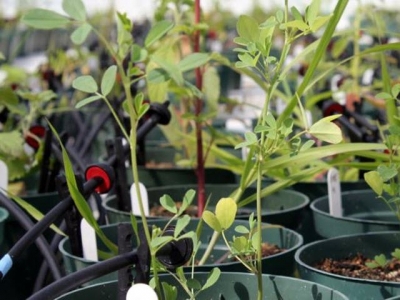Root microbiome valuable key to plants surviving drought

Plants that can recruit particular bacteria to their root microbiomes are much more drought resistant than fellow plants.
Just as the microorganisms in the gut are increasingly recognized as important players in human health and behavior, new research from the University of Toronto-Mississauga (UTM) in Ontario demonstrates that microorganisms are equally critical to the growth and health of plants.
For example, plants that are able to recruit particular bacteria to their root microbiomes are much more drought resistant than their fellow plants, UTM doctoral candidate Connor Fitzpatrick said.
The plant’s root microbiome is the unique community of microorganisms living in and on plant roots. Similar to the gut microbiome in animal species, the root microbiome is the interface between a plant and the world. The root microbiome is responsible for important functions such as nutrient uptake and signals important to plant development.
Fitzpatrick’s study was published in the latest issue of Proceedings of the National Academy of Sciences. His exploration of the role of the root microbiome in plant health could eventually assist farmers with growing crops under drought conditions.
For the study, Fitzpatrick grew 30 species of plants found in the greater Toronto, Ont., area from seed in identical soil mixtures in a laboratory setting. These included familiar plants like goldenrod, milkweed and asters. The plants were raised for a full 16-week growing season, with each species grown in both permissive and simulated drought conditions.
Fitzpatrick’s research explored the commonalities and differences among the root microbiomes of the various host plant species, dividing the microbiomes into the endosphere (microbes living inside roots) and the rhizosphere (microbes living in the soil surrounding roots). He found variation across the 30 species, with related species having more similarity between microbiomes than diverse species.
“It’s as you would expect,” Fitzpatrick said. “Just as there are more similarities between a human’s gut microbiome and an ape’s than between a human’s and a mouse’s, the closer the relationship between plant species, the more similar their root microbiomes. It’s important to document as a way to better understand the evolutionary processes shaping the plant root microbiome.”
In addition to deepening the basic biological understanding of plant evolution and development, the research offers further avenues for study, including how and why some plants recruit bacteria that affect drought resistance while others do not.
“If plants were able to enrich their root microbiomes with a particular group of bacteria, the Actinobacteria, they grew much better in drought conditions,” Fitzpatrick explained. “All of our plants had access to this group of bacteria, but they also needed to have the ability to recruit it from the soil.”
In another finding that is consistent with the practice of crop rotation, Fitzpatrick evaluated plant soil feedback and demonstrated that the more similar the composition of a plant’s root microbiome to that of the previous generation of a plant grown in that soil, the more the second-generation plant suffered.
“There is a complex web of interactions taking place that is difficult to disentangle and requires further inquiry,” Fitzpatrick said.
“Practically speaking, we need to understand how to sustain plants with all of the mounting stressors today, such as drought and an increase in pathogens (e.g., plant disease),” Fitzpatrick said. “The efforts to mitigate these issues are expensive and short-lived or very damaging to the environment. If we can harness naturally occurring interactions for these purposes, we’ll be much better off.”
Related news
 Cashew industry lowers export goal
Cashew industry lowers export goal iệt Nam’s cashew industry has targeted 300,000 tonnes of cashew exports at a value of US$3 billion this year, a year-on-year reduction of 50,000 tonnes
 Positive signs for Vietnam's rice exports
Positive signs for Vietnam's rice exports Vietnam’s rice export industry has a bright future with good contracts after having a successful year.
 Vietnam’s path to become world cashew king
Vietnam’s path to become world cashew king Vietnam has overcome India, the world’s largest and long standing cashew nut processing and export nation for 12 years, and now continues leaving the country